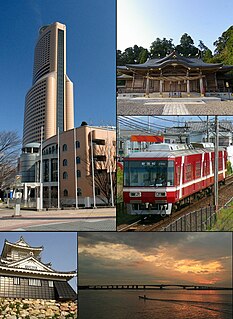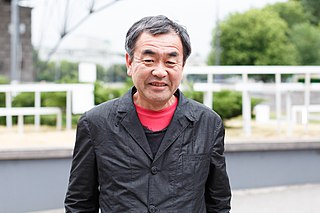
Mokutarō Kinoshita was the pen-name of a Japanese author, dramaturge, poet, art historian and literary critic, as well as a licensed doctor specializing in dermatology during Taishō and early Shōwa period Japan. His other pen names included Horikason (堀花村), Chikaisshakusei (地下一尺生), Sounan (葱南) and others. As professor of dermatology and a noted leprosy researcher, he served at four universities.
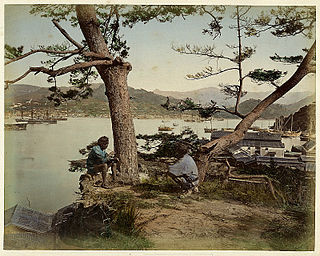
Uchida Kuichi was a pioneering Japanese photographer from Nagasaki. He was greatly respected as a portrait photographer and was the only photographer granted a sitting to photograph the Emperor Meiji.
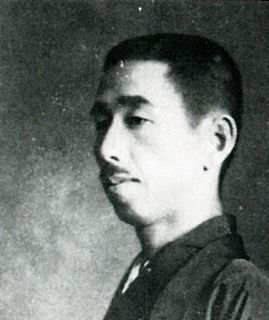
Kinoshita Rigen was the pen-name of Japanese author Viscount Kinoshita Toshiharu, noted for his tanka poetry, active in Meiji period and Taishō period Japan.
Ōri Umesaka was a Japanese photographer. He was considered a major figure of mid-century Japanese photography.
Akira Kinoshita was a Japanese photographer who specialized in photographing musicians.
Kojima Ryūa was a renowned Japanese photographer. He had a studio at Inabaguchi in Gifu. He experimented with forms, including collages where he used his family as models. He also experimented with chemistry.
Meison Kobayashi was a Japanese photographer. He was a member of the Naniwa Photography Club.
Shimizu Tōkoku was a Japanese photographer.
Shimooka Renjō was a Japanese photographer and was one of the first professional photographers in Japan. He opened the first commercial photography studio in Yokohama, and in Japan he is widely considered the father of Japanese photography.
Minayoshi Takada was a Japanese photographer from Nagoya. He was a driver of modernist and constructivist photography in Japan.
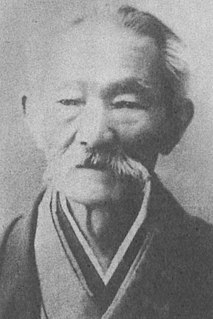
Tamoto Kenzō was a Japanese photographer. He was born in Kumano, in the Mie Prefecture of Honshu. When he was twenty-three, he moved to Nagasaki to study western culture. In 1859, he relocated to Hakodate, where he lost a foot due to frostbite. The surgeon who amputated his foot had an interest in photography, specifically ambrotypes, and Tamoto became his apprentice. It was not until 1866 that he began working as a photographer. In 1867, he photographed the construction of the last castle to be build in Japan, Fukuyama Castle. Tamoto took photographs of military leaders Enomoto Takeaki and Hijikata Toshizō during the Battle of Hakodate between 1868-1869. Tamoto opened his own portrait studio in Hakodate in 1869. Starting in 1871, he documented the improvements to infrastructure in the Hokkaido region, eventually presenting 158 photographs of the process to the Settlement Office.
Kanbei Hanaya was a Japanese photographer. He was born in Osaka in 1903. In his twenties, he travelled in China and studied photography in Shanghai. In 1929, he purchased a photography supply shop in Ashiya, a city in Japan's Hyōgo Prefecture. The Ashiya Camera Club, a prominent feature of the New Photography movement, formed at the shop in 1930. Its membership included Iwata Nakayama, Kichinosuke Benitani, Juzo Matsubara, and Korai Seiji. The group began exhibiting in 1930 and published its first yearbook in 1931.
Narutoshi Furukawa was a Japanese photographer. He was born in Karatsu, Saga Prefecture. His grandfather was Shumpei Furukawa, himself a photographer. Furukawa graduated from the Tokyo School of Fine Arts in 1922. In 1930, he joined the New Photography Research Society; several of his photographic montages were published in the group's journal. He retired from photography in 1955 but became a professor at the Tokyo Junior College of Photography. He was made a professor emeritus there in 1982.
Kinoshita is a Japanese surname. Notable people with the surname include:
Naoyuki is a masculine Japanese given name. Notable people with the name include:
Yukina Fujimoto, known by her maiden name Yukina Kinoshita, is a Japanese model, actress, and television personality. She was a member of the musical group Pabo alongside Mai Satoda and Suzanne, all three of whom were later grouped with Shuchishin as members of Aladdin.
Houka Kinoshita is a Japanese actor who is represented by the talent agency, Cast Power. He graduated from Osaka Prefectual Nozaki High School and Osaka University of Arts.
Takuya Kinoshita is a professional Japanese baseball player. He plays catcher for the Chunichi Dragons.
Takanori Kinoshita was a Japanese artist known for paintings which combine Western subject matter with the aesthetic qualities of the Shōwa period.
Eiju Otaki, born 1932, was a Japanese photographer and photojournalist active in the 1950s.

